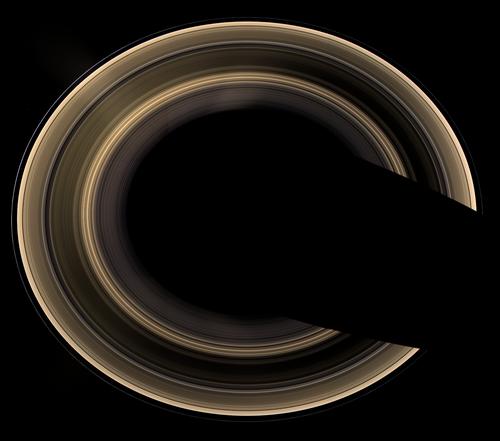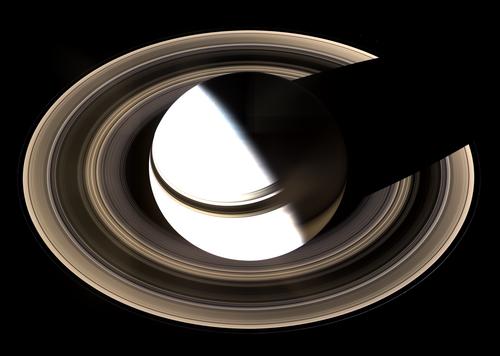The Hubble Space Telescope (HST) has produced some of the most famous still images in astronomy (e.g., the pillars of creation in the Eagle Nebula). The latest images from HST are movies of Saturn and its moons. Astronomers wrote software that multiplies the relatively small number of images taken by Hubble for each event into the much larger number needed to make a movie. The original images covered several hours of observing time, and the videos range in length from 15 to 30 seconds, so time is compressed in the videos and the motions of Saturn and its moons are speeded up.
Two of the videos show Saturn with the rings edge-on either to Earth or to the sun. In this video, you can see Saturn's largest moon Titan and a smaller moon Tethys as they orbit the planet.
Actually you see Titan's shadow falling on the planet first, before the moon itself appears and crosses the face of the planet. Tethys emerges from behind Saturn on the left and quickly whizzes across the ring plane and vanishes off to the left.
Tethys makes a brief appearance in this video as well, although again you just catch a glimpse of it (this time on the upper right); Mimas, Enceladus, and Dione are the center of attention.
This one is interesting because not only do three of the little moons cast shadows on the face of the planet, but Enceladus and Dione also cast shadows across the rings. It's one of the coolest instances of light and shadow I've seen in awhile.
The focus of the third video is Saturn itself. With the rings tilted toward Earth to the greatest extent possible in March 2003, the southern hemisphere of Saturn was well exposed for viewing.
The 24-second video shows a time-lapse version of the planet's rotation (it takes about ten hours to make a complete rotation). The ice and rock in the rings is distributed so evenly that you can't detect their rotation, so it looks like the planet is spinning while the rings hold still. Then the video zooms in for a close-up of the storms and bands of clouds that make up Saturn's surface features, with the contrast stepped up to make the features more obvious.
And if that's not enough Saturn for you, check out this unusual still image, which shows Saturn from above the ring plane.

The Cassini spacecraft recently made a polar pass over Saturn, and the views of the rings from above are stunning. The planet was so bright it's blocked out, but you can see its shadow across the rings. This image shows the planet and the rings; you can see both the shadow of the rings on the planet, and the shadow of the planet on the rings.

You can also see a little strip of terminator, where sunlight and darkness meet on the surface of Saturn; in that area you can make out some of the surface features.





Comments